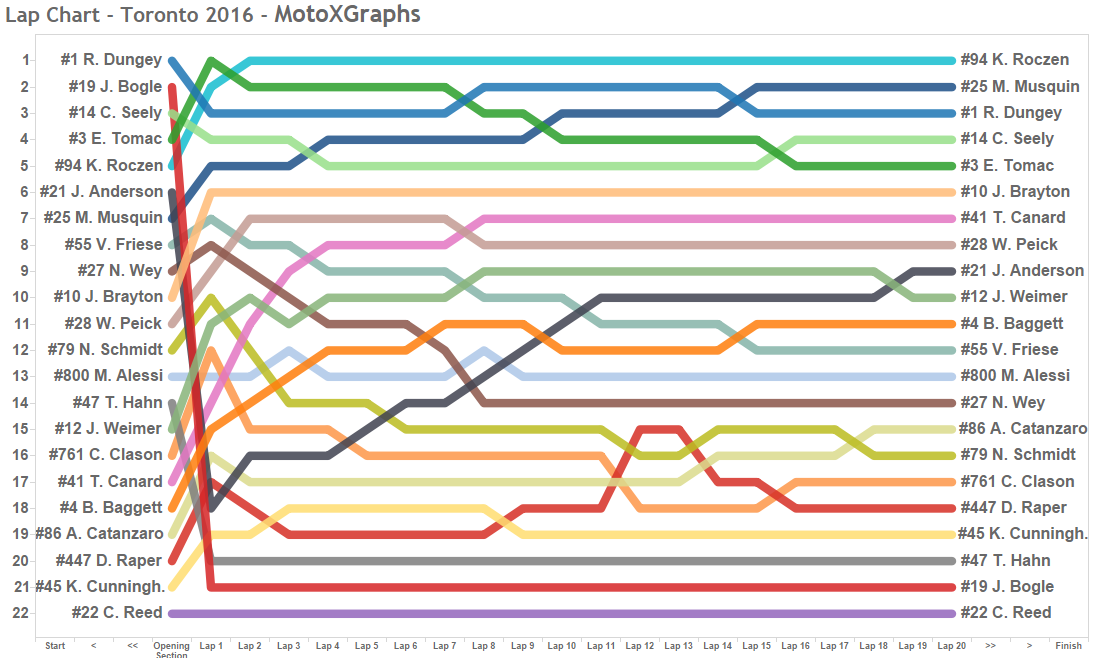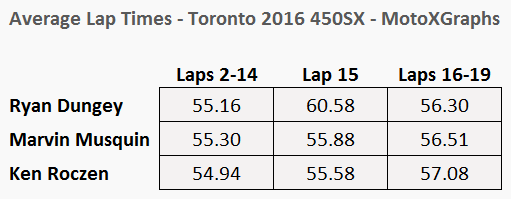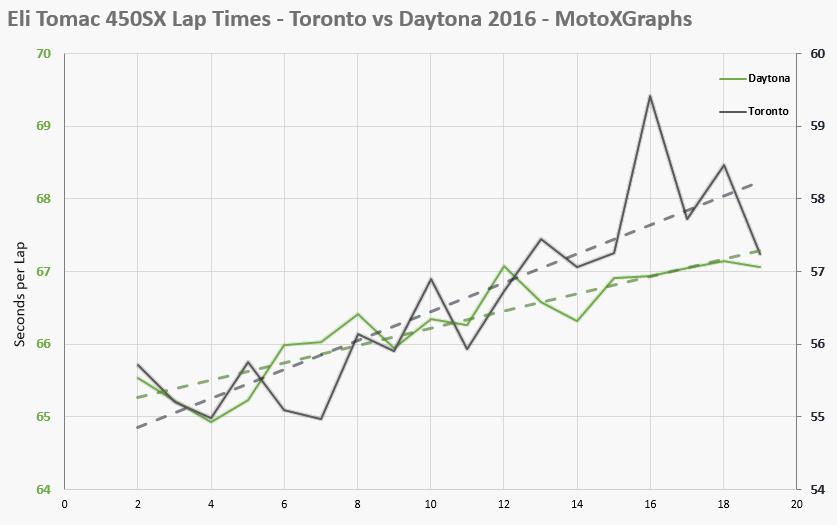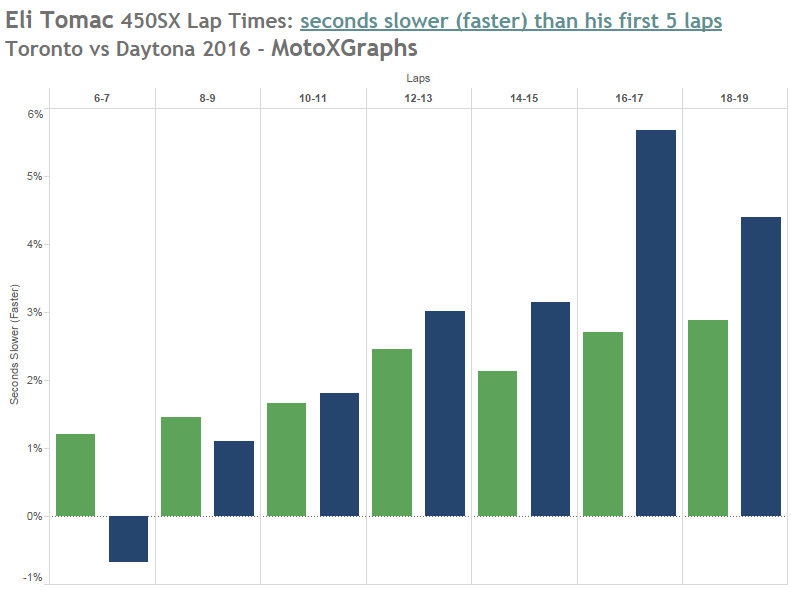2016 Week 10 - By-The-Numbers Recap: Toronto
3/13/2016

Some entertaining racing in Toronto, especially up front in the Top 5 and even in the next 5. Although Justing Bolge's mistake and the ensuing pile-up put a bit of a downer on the race for many. But the real excitement (not really) is that the stadium-effect prophecy for Justin Brayton and Jake Weimer proved correct! Well, maybe, but we'll address the predictions and stadium-specific adjustment below.
While Ken Roczen didn't particularly impress in qualifying (7th) or his Heat Race (3rd, though he did pass Marvin Musquin in lap 5 of 6), his Main Event couldn't have gone better. He got a good enough start, avoided the Bogle pile-up, then passed Cole Seely, Ryan Dungey, and Eli Tomac in short order. He made passing them look easy, then cruised to victory without much of a challenge.
Marvin Musquin had another great day, outracing everyone except Roczen and making his way to 2nd in the final. He qualifying 3rd, and then he was 4th in his heat (not as great). Early on in the Main Event, it seemed he'd settled in to 4th/5th place battle with Seely, but then he moved up to challenge Tomac for 3rd. After passing Tomac, I think we all figured he'd stay there in 3rd behind his superior teammate Dungey. But to the surprise of the announcers--and apparently the producers in the video truck--since we didn't hear or see anything until a while after Musquin passed Dungey. More on that below.
In laps 2 through 19, Ryan Dungey's average lap time was 55.71 seconds while Musquin's was 55.60 (ignoring laps 1 and 20). So we might conclude that Musquin was just a bit faster on the day. But, on Lap 15, where Musquin passed him, Dungey's lap time was 60.58, 5 seconds slower than his other laps. We couldn't see what happened on the broadcast, but at one point Dungey was 3.8 seconds behind the leader, then all of a sudden he was 7.3 seconds behind -- and Dungey's lead on Musquin simultaneously shrank from 3.3 seconds to 0.9. At the next section, Dungey was 8.8 seconds behind the leader, and Musquin had passed him, at 7.4 seconds behind the leader, so that 0.9 seconds lead for Dungey turned into a 1.4 seconds lead for Musquin. (According to RacerX, Dungey "ended up sliding out. He didn't crash but lost time….")
If we look only at laps other than Lap 15, Dungey's average would be 55.43 seconds, which is faster than Musquin's 55.60 average, from above. Basically, in sections of the race other than Lap 15, Dungey was faster than Musquin, see below (I threw in Roczen for comparison's sake):

Though the early headlines might indicate that Musquin was faster than Dungey, that's only partly true. It appears that without that Lap 15 mistake, Dungey was clearly faster. But Dungey did make the mistake, which cost him 2nd place.
Cole Seely got a good start with the top several riders, but he couldn't keep pace with Roczen, Tomac, and Dungey in the first lap, slipping to 4th, then 5th when Musquin passed him on Lap 4. Seely challenged Musquin all race, and Seely passed Tomac in Lap 16 as Tomac wasn't able to keep up his early speed.
Speaking of which, Eli Tomac's day started well by qualifying 2nd, winning his Heat Race, then coming out of the opening turn in 4th. He immediately passed Dungey and it looked for a moment like we might be seeing Daytona all over again, where Tomac takes off and outruns everyone. But Tomac's momentum from last week vanished entirely by Lap 2 when he was passed by Roczen. From there, Tomac couldn't maintain 2nd place, as he got passed on Lap 8, Lap 10, and Lap 16 -- and he was battling to hold off Brayton up through the finish line.
At Daytona, Tomac managed to hold his pace throughout the race as well as or better than Dungey. That had been a problem for Tomac -- slowing down more than the other top riders as the race went along -- in many races prior to Daytona. Was Daytona a sign that perhaps Tomac was back to 100%, and this wouldn't be a problem as the season went on, we wondered? But, the problem was clear again -- without even looking at the numbers -- for Tomac in Toronto as he started fast then dropped off and got passed 4 times. But let's look at the numbers anyway, for laps 2 through 19: in Daytona, Tomac slowed by 0.12 seconds per lap; in Toronto, 0.20.

That difference of 0.08 seconds per lap is clear in the two trendlines. If we include Lap 20, the numbers change slightly, to a difference of about 0.06 seconds, still about a 50% increase compared to Daytona.
Some of this may be an effect of the track and/or because laps at Daytona were about 10 seconds longer than the laps at Toronto. To get around that, we can view it in % terms, so here we look at how the lap times in the first 5 laps compare to the remaining laps -- as a % of the overall average for Tomac in each race. I've condensed the bars so that each bar is the average of two laps. So, for instance in laps 12 & 13, Tomac was about 2.5% slower than his first 5 laps at Daytona while at Toronto he was 3% slower:

And that trend gets worse as we look at laps 14 - 19. But, in laps 6 & 7 at Toronto he was actually nearly 1% faster than his first 5 laps -- Lap 7 was his fastest lap of the day, and Lap 6 was his 3rd-fastest. Tomac said after the race: "My heart rate spiked early in the race and I never recovered." Which may be his way of saying he went out too fast and that caused him to be unable to hold off Dungey, Musquin, Seely, and almost Brayton. After Tomac put up his fastest lap time of 54.973 in Lap 7, he dropped to 56.142 in Lap 8 -- 1.169 seconds slower.
Justin Brayton held on to 6th throughout virtually all of the Main Event, and as mentioned he nearly caught Tomac at the end. That's Brayton's 2nd-best finish this season, after 5th at Atlanta; his average finishing position has been 8.5. In our "True Talent" projections going into Toronto, we included an (experimental) adjustment for how well the riders would perform at a certain stadium, in this case the Rogers Centre. Brayton's adjustment was positive, expecting him to outperform his non-adjusted projection by 1.5 places in the leaderboard. Lo and behold, Brayton beat his season average in Toronto, but by even more -- 2.5 spots. We're talking about the smallest of samples -- 1 -- so this isn't exactly "proof", but it is interesting, especially because one of the other major "stadium" adjustments was for Jake Weimer.
Jake Weimer ended up in 10th, just running out of time to hold off Jason Anderson for 9th. Our pre-race prediction for Weimer was 13th for Week 10 (16th, but Justin Barcia, Davi Millsaps, and Broc Tickle were not racing). When we added in the stadium adjustment for Toronto, he moved up to #10. And his 10th place beats his season average finish of 11.8. So that also looks good for the stadium adjustment, although the one other major adjustment we had did not materialize: Mike Alessi finished 13th, beating his season average of 14.9, but the projection expected him to finish worse than normal by 4.6 spots.
What makes the stadium adjustment still in the "experimental" stage is primarily the small sample size, and that was on full display in Toronto, where Bogle's crash messed up the race for at least four or five riders, riders who may have finished in front of Brayton, Weimer, or Alessi had the wreck not happened. And that type of wreck is not something that the numbers can really incorporate into the forecast (at least not yet!).
For instance, because of the Bogle wreck, Trey Canard had to go from nearly the back of the pack in Lap 1, though he did manage to rebound to 7th. It's a shame because Canard had put up the best qualifying time and won his Heat Race, so he seemed to be on his best game (although before running into the Bogle pile-up, Canard was not off to a good start as he appeared to be somewhere around 17th). Once he emerged from the pack, around Lap 5 I would say, he averaged 56.2 seconds per lap, which was good but not as good as Musquin (55.7) or Dungey (55.9) over those same laps (5 through 19).
Maybe the most notable innocent bystander was Jason Anderson, who had no way to avoid Bogle's downed bike, and really was lucky he wasn't hurt. But when Anderson ran into Bogle, Anderson was in about 6th place, where he would have had a shot at the top spots. Instead, he found himself in 18th (or worse, it was hard to tell) and had to ride from behind, managing to get all the way back to 9th. Curiously, in laps 5 through 11, in each lap Anderson passed one person and only one person (except lap 7).
To wrap things up, here's an update to the "Passing Score", to give an idea of how much passing was going on at different races/tracks. One thing to keep in mind, and this could be updated in future versions, is that longer tracks probably have more opportunity for passing, so maybe the chart should include "passes per minute" or something along those lines. Also, in races like Toronto--where 3 riders were DNF before the first lap was done--probably deserve some sort of asterisk since we're looking at 19 riders for almost the entire race instead of 22.
Posted by: SagehenMacGyver47 ::: As always – Feedback welcomed
Previous: 2016 Supercross Predictions - 450SX Update going into Week 10 at Toronto | Back to Blog | Next: Update On Passing Index